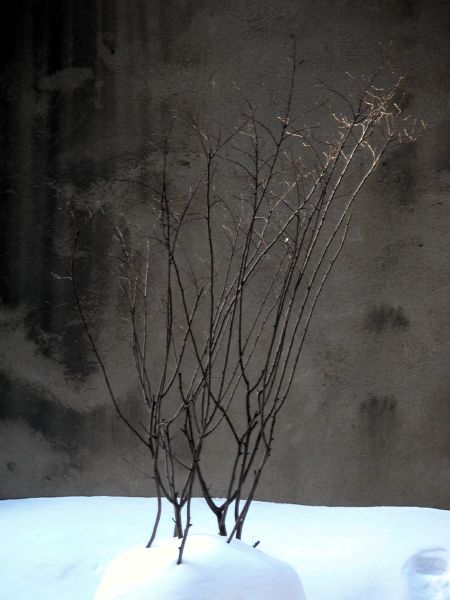NYC: January 2005 Archives
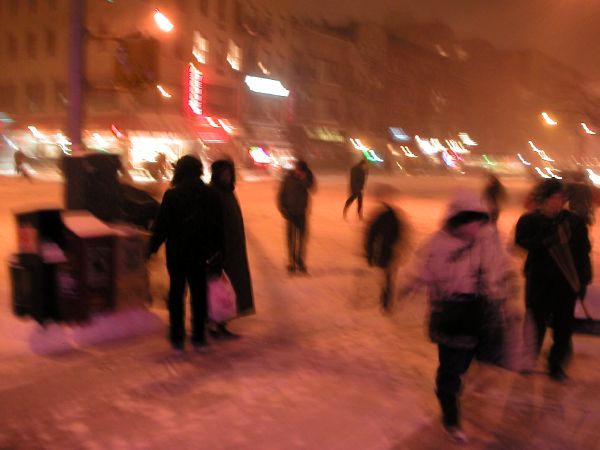
the corner of 23rd Street and 8th Avenue tonight at 7 o'clock
We were on our way to a gallery opening. The "impressionist" blur is the result of the slow shutter, but it's pretty close to what it looked like to those who were out there in the wind-driven snow (ten inches or so already) without goggles. Hey, Childe Hassam did this stuff with oils and nobody laughed. But I guess that was a hundred years ago, and there was a little more involved than pressing a button on a tiny box.

below the railroad viaduct called the High Line, "CONSERVING FOR TOMORROW"
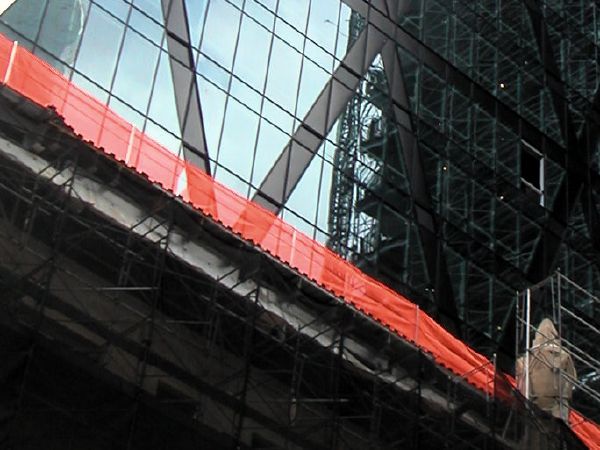
I hadn't noticed until recently that Sir Norman Foster's exciting project for completing the 1928 Hearst Building in midtown Manhattan includes a relatively small but significant salute, or nod, to the design of the art deco original.
In the photo above, note the chevron shapes on the stylized urns at the top of the surviving shell of the early building. These ornaments are repeated all along the parapet. Foster's tower rises above all this, and uses its diagonal device structurally, on an enormous scale.
The photo below shows much of the current height of the massive new construction, and the top eight floors are still to be built. That is, otherwise imagined, there are still two layers of triangles or one full layer of X-bracing to go up beyond what you see on the street today. The completed building is going to look much larger than it appears in the architects' renderings.
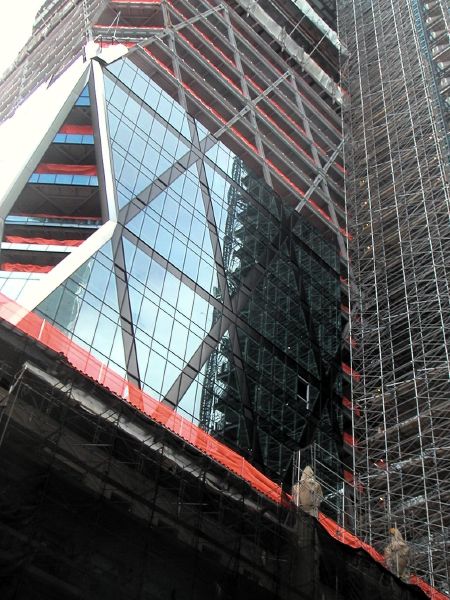
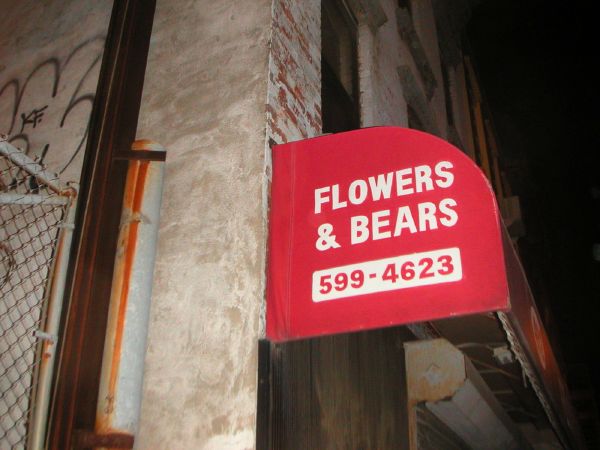
untitled (Metropolitan Avenue marketing) 2005
GÃŒnther Domenig, on the architect's imagination.
I love visiting the Austrian Cultural Forum building. Once you've greeted the very-New York concierge guy behind the desk inside the door of the narrow 24-story tower on 52nd Street, you could actually be in Wien. The two-year-old building designed by Raimund Abraham is that modern. And, yes, I really mean that about the city. The former capital of the Austro-Hungarian empire is no longer just old. Go see for yourself.
Anyway, back in New York, yesterday I stopped by the Forum's current exhibition, âGÃŒnther Domenig: Structures that Fit My Nature,â which unfortunately offers only a tantalizing and impressionistic glimpse of the work of the interesting Styrian architect GÃŒnther Domenig. The modest spaces which occupy four levels of the building are mostly devoted to just two projects, the Steinhaus in Steindorf, KÀrnten (Carinthia) and the Dokumentationszentrum (Documentation Center) in Nuremberg, and there is precious little guidance to those (the supply of the show's brochure had been exhausted long before I arrived).
The first structure is Domenig's own still-evolving dwelling and offices on the shores of a vacation lake, and the second is his striking deconsecration of the notorious Nazi Party Rally Grounds.
One of the most useful (and stylish) elements of the installation was the wall-size video screen interview with the architect (edited as a monolog spliced with photographs of his work) which occupied one of the rooms. I think it should be recommended viewing for anyone who wishes to understand where truly new architecture should start. I wish I had taken notes, but Domenig says something profound about the relationship between the architecture in the architect's head and the architecture which has to be constructed in the messy real world.
I loved the little wooden dock shown in the video; it seems to have made the transition.
The causes for his repeated exasperation, and his extraordinary perseverance in the face of enormous obstacles, helps to explain why we get almost no truly exciting buildings in New York these days. We have to insist on great patrons as well as great architects.
the dream
[GÃŒnther Domenig STONEHAUS, Relations PPP 1987 pencil and color pencil, installation view]
ADDITIONAL PROGRAMS
The Cultural Forum has some more wonderful programming lined up over the next two months. First there will be an exhibition of figurative works by Austrian artists and others called "Slices of Life: Blueprints of the Self in Painting." It opens with a public reception on Tuesday, January 18, from 6 to 8pm. The artists include Amy Cutler, Plamen Dejanoff, Nicole Eisenman, Johanna Kandl, Elke Krystufek, Muntean/Rosenblum, Katrin Plavcak, Lisa Ruyter, Markus Schinwald, Ena Swansea, Nicola Tyson and Gregor Zivic. (I'm having fun trying to imagine which of these artists has a connection with Austria, especially if I imagine connections something other than that of birth.)
Beginning the next day there will be a number of chamber music, lieder concerts and film programs in the building's small, two-level jewel-box theatre. Somewhat exceptionally for this institution whose expressed mission (encouraging and describing the impact of the digital world on the arts and culture at large) has meant that it has hosted some very exciting new stuff, the January and February programs are limited to composed "classical" music, although they range, almost all somehow Austrian, from Haydn and Schubert through Mahler, Berg, Schulhoff and Krenek, to PÀrt and Kurtag.
I'll be there January 18, but I'm also going back for the music and the films. There's always the building too, and maybe I'll get further upstairs some day. I still haven't seen almost 20 of those tantalizing 24 stories.
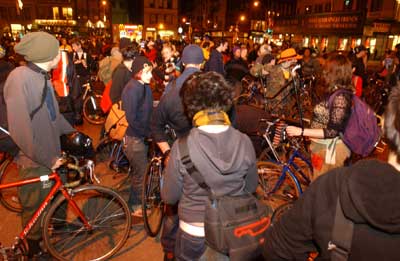
including at least one farmer and feed dealer
There's a fairly happy story in Newsday this morning, reporting the relatively unaggressive approach of NYC police to last night's local Critical Mass.
The monthly event promoting pollution-free transportation went off almost without incident, marking the first time since the Republican Convention in August that police did not harass the participants.*
The numbers were down from those recorded on recent Fridays, perhaps because of winter and the holiday, but more likely because many enthusiasts would have feared a repeat of unprovoked police violence, indiscriminate incarceration and illegal confiscation of bicycles. News of last night's peace should produce larger turnouts in the [warmer] future.
After the news of the success of the ride, my favorite part of Wil Cruz's article is the attribution of a quote near the end which criticizes ambiguous police direction. The speaker is described as "Jack Horowitz, 57, a farmer and feed dealer from the South Bronx."
I read this to Barry and he immediately added to my own glee: "That's why I love New York!"
*for recent history, see this September link and this one from late October.
[image by Joel Cairo from Newsday]
